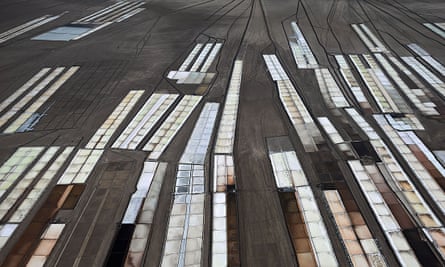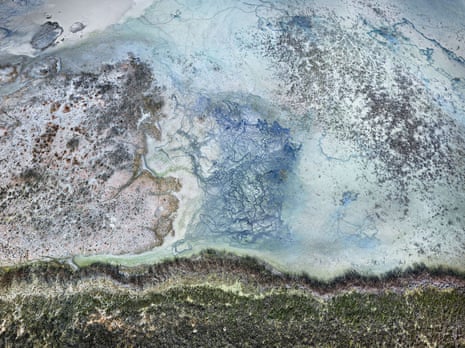Rectangles of pale blues and greens lie scattered across a sea of grey sand, looking a bit like someone dropped their Farrow & Ball colour swatches in a cat litter tray. The mottled grey background is marked with faded layers of scratches and scribbles, like an endlessly reworked charcoal drawing, from which the little blocks of colour shine out as bright jewels in the dust.
This is what the salt pans of Gujarat in northern India look like, when seen through the painterly bird’s-eye lens of Edward Burtynsky. The 61-year-old Canadian photographer has devoted his career to capturing man’s impact on the landscape from above, elevating the brutish debris of slag heaps and open-cast mines into sublime wall-sized hymns to how we’ve made our mark on the surface of the Earth. And he’s on a mission to document it all before it’s too late.
“I happened upon the salt pans on Google Earth one day,” he says, sitting in east London’s Flowers Gallery, where an exhibition of his work opens on 16 September. “A few months later I was in a Cessna flying over them, trying to capture this incredible terrain before it disappears.”

Home to more than 100,000 salt workers, who extract around a million tonnes of salt a year from the floodwaters of the Arabian Sea, the remarkable lunar landscape of the Little Rann of Kutch might not exist for much longer. The industry is under threat from receding groundwater levels and declining market values, potentially putting paid to a way of life and land-forming that has existed here for over 400 years.
Like most of Burtynsky’s work – which graces collections from Tate to MoMA and the Guggenheim – when you first see these pastel-hued planes of lines, squares and scribbles, it’s not quite clear what you’re looking at until you peer a bit closer. The furrows in the dappled grey backgrounds, which have the ghostly patina of an etching, turn out to be the tracks of trucks and the grooves of dykes and berms, dug out to stop the desert sand from blowing into the salt pans.
“I like it when the viewer can’t ‘get it’ instantly,” says Burtynsky, poring over one of his two-metre wide prints to find a clue that proves we are looking at a river delta, not just an abstract swirl of reds and browns. Like spotting the striped red jersey in a Where’s Wally illustration, there is a satisfaction that comes from decoding the signs of life and industry in one of his sprawling scenes. “You should have to dig in with your eyes to work out what’s going on.”

He’d like you to dig in a little with your brain too, because these glossy visions are no mere enviro-porn. “There’s definitely a ‘holy shit!’ aspect to the work,” he says. “We’re at a critical moment in history where we’re starting to hit the thresholds of human expansion and the limits of what this planet can sustain. We’re reaching peak oil, peak fish, peak beef – and the evidence is all there to see in the landscape.”
Since his interest was first sparked in man’s imprint on the environment in the 1980s, when he was working part-time in a Canadian gold mine while studying photography, Burtynsky has produced major bodies of work on everything from the oil industry and mining to quarrying and water, the most recent of which have expanded in scope to include documentary film-making.
To achieve his favoured god-like perspective, he began with high vantage points and tall tripods, then graduated to telescopic hydraulic poles (think of a 50ft selfie stick), then planes and helicopters, and now computer-controlled drones. His team scouts potential subjects from the comfort of Google Earth, then with GPS technology Burtynsky can fix a position in the air by latitude, longitude and altitude, and send a drone-mounted camera back again and again to the exact same spot until he’s happy with the shot.
He is currently engaged in a five-year project on the anthropocene, the pending name for the present geological age in which humans have had a discernible impact on the environment, working in collaboration with scientists from the international Anthropocene Working Group. “We’ve had the five great extinctions,” he says, referring to prehistoric devastations from the “Great Dying” of the Permian eruptions, to the asteroid that wiped out the dinosaurs. “Now humans are having the equivalent effect of that meteor impact.”
If his message is one of impending catastrophe – or indeed a catastrophe that’s already happened – it is tempered by the fact that these manmade scars are incredibly seductive. Who could deny the alchemical allure of the toxic phosphor tailings ponds in Florida, or the beauty of the scrubby patchwork quilts left by mass deforestation? As Burtynsky admits, his images would be equally at home on a Greenpeace poster or the cover of an oil company’s annual report. “The work asks more questions than it answers,” he says. “Which is what artists are there to do.”

Further questions are raised in a new book that accompanies the exhibition, Essential Elements, which pairs his photographs, sometimes by tonal values or patterns, rhyming the forms of rice terraces with those of oil fields, but also by narratives that hint at a more critical agenda. On one spread, the mirror-glass skyline of Toronto, shot in the late afternoon sun, faces a gnarled hole in the ground in Australia, the sunset pinks and turquoises echoing the sandy soil and greenish lake at the bottom of the copper mine. “We build cities and leave holes in the ground where they came from,” says Burtynsky. He refers to quarries as “inverted skyscrapers”.
Flicking through the book is like touring the landscapes of late capitalism, tracing the supply chains of our consumer culture back to both ends – where the stuff came from and where it ends up. A field of shiny motorbikes is paired with a heap of tyres, an iron-ore mine with a ship-breaking yard. His post-production can be a little heavy-handed with the contrast and saturation levels, in the quest for pin-sharp clarity. But this is also part of his conscious aesthetic: images are pumped up until the entire picture plane is flattened into a surface seething with granular detail, or what he calls “the democratic distribution of light and space across the whole field,” a neutrality that encourages the eye to wander.
The flattening of these gaping scenes plunges the viewer headlong into the dams and reservoirs, aqueducts and deltas of this global survey. It brings a visceral sense of places that have been drained, drilled, excavated and extracted, terrains that have an archaic, almost primordial feeling. This is the fundamental matter from which human civilisation has been wrought, the landscapes that have been squeezed and scraped for their material worth, ravaged and disfigured on an epic scale, leaving beautiful residue in their wake.
“In our ephemeral information age, people think we’ve left behind the stone, bronze and iron ages,” says Burtynsky. “But they’re all still going on – we use tonnes of this stuff every day. You just have to look.”

Comments (…)
Sign in or create your Guardian account to join the discussion